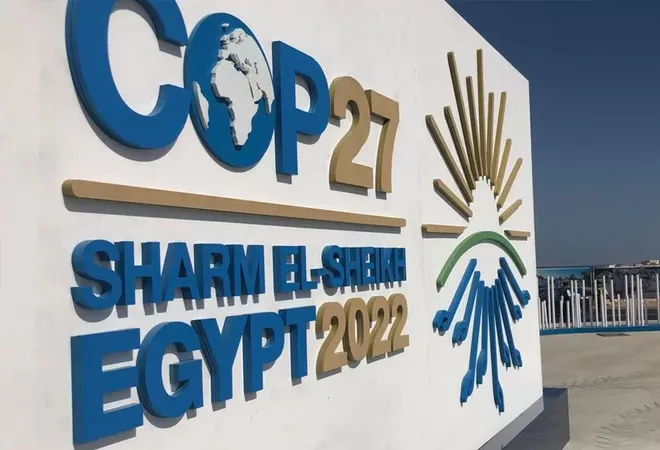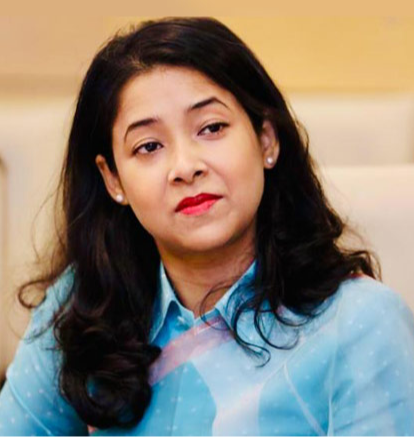
This piece is part of the series, Common But Differentiated Responsibility: Finding Direction In COP27
As the world congregates at the COP27 in Sharm El-Sheikh, Egypt to reassess and reiterate actions urgently required to limit global warming and adapt to its consequences, the recently released United Nations Environment Programme’s Adaptation Gap Report 2022 presents a disturbing picture. It projects that the impacts of climate change are set to increase in frequency and intensity in the coming years even if the world begins to bring down greenhouse gas emissions (GHGs). Developing countries of the Global South are most vulnerable to these disproportionate impacts of climate change, despite having contributed the least to global carbon emissions. According to the Intergovernmental Panel on Climate Change (IPCC) report, ‘Climate Change 2022: Impacts, Adaptation and Vulnerability,’ currently around 3.6 billion world’s population live in highly vulnerable climate contexts. The majority of this population is concentrated in developing countries of the Global South. The lack of capacity, equity, and adequate resources coupled with already existing development challenges constrain the ability of these countries to mitigate or adapt to uncertain climate risks. In the absence of stronger efforts, this scenario is set to worsen even further, with vulnerable communities of the developing nations continuing to be on the frontline of the crisis.
Developing countries of the Global South are most vulnerable to these disproportionate impacts of climate change, despite having contributed the least to global carbon emissions.
Limiting global warming to 1.5°C would mean global emissions must halve by 2030 and reach net zero by 2050. However, the world's current climate pledges are far off track to limit climate change to the agreed levels. The world powers have clearly failed to provide effective climate leadership. To address the uncertain, yet projected severe future climate consequences, developing countries would look up to the COP27 for a strong new leader who can fill the vacuum in climate governance and push for collective efforts to combat climate change.
India: An emerging climate leader
India is poised to fill this gap. India has displayed immense credentials, commitment, and leadership potential by taking affirmative action in mitigating as well as adapting to climate change. India is the only G20 country that is on track to achieve its climate targets. In its recently updated Intended Nationally Determined Contribution (NDC), India has committed to reducing emissions intensity of its GDP by 45 percent by 2030, from 2005 level and achieve about 50 percent cumulative electric power installed capacity from non-fossil fuel-based energy resources by 2030. Prime Minister Narendra Modi's recently launched LiFE "Lifestyle for Environment" mission, and as India is leading the International Solar Alliance as well as the Coalition for Disaster Resilient Infrastructure, it stands as a shining example of how stronger climate actions could be successfully aligned with development imperatives.
But, how can India use its influence to push for an equitable and inclusive framework at COP27 that can translate the common climate goals into action? How can India ensure that effective development partnerships are built at COP27 to assist developing countries in addressing the multifaceted climate risks?
Prime Minister Narendra Modi's recently launched LiFE "Lifestyle for Environment" mission, and as India is leading the International Solar Alliance as well as the Coalition for Disaster Resilient Infrastructure.
First, while pushing for ‘fair negotiations’ at COP27, India must emphasise the full implementation of the UNFCCC’s principle of Common but Differentiated Responsibilities and Respective Capabilities (CBDR–RC). Not only do the developing economies bear diminished responsibility for global warming, but their current per capita emissions are also very low. Given the significant inequality in the per capita emission between the developed and developing nations, it would be unjust, for example, to expect a developing country such as India—which emits less than 1.9 Mt CO2 per capita—to undertake the proportional costs associated with climate actions with developed nations such as the United States (US) with 15.52 Mt CO2 per capita emission. India must stand firm in its demand that developing countries must be accorded adequate time, financial, and technological assistance and policy space to transit to a low-carbon future.
The current climate governance architecture does not provide clarity over what constitutes as a “fair share” of GHG reductions for each country. The signatories to the Paris Agreement are required to voluntarily define their own NDCs or emission reduction targets, assess their performances, and prepare future climate commitments. In the absence of a just and transparent mechanism to review the adequacy of the NDCs from each country, there would continue to remain a clear policy gap in climate change mitigation efforts from developed countries. The UNEP points out that developed members of the G20—collectively responsible for around 75 percent of global GHG emissions—are not on course to meet their climate targets.
As a voice for the developing world, India should push the developed, wealthy nations to step up their efforts on climate action. In this endeavour, it must lead the COP27 to become an opportunity for the developing nations to reaffirm their collective beliefs in the principles of equity and inclusivity in charting a collective path for climate goals.
The signatories to the Paris Agreement are required to voluntarily define their own NDCs or emission reduction targets, assess their performances, and prepare future climate commitments.
Second, India should ramp up pressure on the developed countries for intensifying commitment to finance and extend technology transfer. This would help in assisting developing countries build their resilience and adapt to climate change and resulting disasters. IPCC report claims that between 2010 and 2020, climate-induced extreme weather events such as droughts, floods, and storms have killed 15-times as many people in highly vulnerable developing countries compared to developed wealthier nations.
The UNEP estimates that developing countries currently require US$70 billion annually as adaptation costs are set to vary between US$140 billion to US$300 billion per year by 2030. The current commitment of financial assistance of US$100 billion a year from developed countries for both mitigation and adaptation is grossly insufficient to assist developing countries adapt to worsening climate impacts. To confront adaptation challenges, the international community must ensure that high-vulnerable populations have the finance, technology, strengthened capacity and institutional resources required to adapt. India must demand that COP27 lays out a detailed set of guidelines on the mobilisation of climate finance for adaptation, its sources, followed by a thorough governance and accountability framework that can guide its effective implementation.
Third, while the adoption of 'Loss and Damage' (L&D) as an agenda item at COP27 is a welcome development for vulnerable countries, India must ensure that negotiations engage with the issue constructively and dedicated the urgent focus it deserves.
The current commitment of financial assistance of US$100 billion a year from developed countries for both mitigation and adaptation is grossly insufficient to assist developing countries adapt to worsening climate impacts.
The IPCC has highlighted that even the most effective adaptation measures would not be able to prevent all losses and damages in vulnerable regions. India, thus, must push that the operationalisation and funding of the Santiago Network on Loss and Damage (SNLD) be expedited, which can “catalyze the technical assistance of relevant organizations, bodies, networks and experts, for the implementation of relevant approaches for averting, minimize and addressing L&D at the local, national and regional level, in developing countries that are particularly vulnerable to the adverse effects of climate change.” COP27 will be the most important chance for India to push for the establishment of a dedicated finance mechanism to support the vulnerable regions cope with climate impacts in a robust and effective manner.
India has the most important responsibility at COP27—to bring the international community ‘together for implementation,’ as they must stand in ‘solidarity’ to address the compounding climate crisis. The world would be keenly following India’s leadership role in climate action at COP27 and G20. It must convince the developed world that their inaction or failure to support developing countries adapt to worsening climate impact today will influence the scale of devastation tomorrow. That will require more radical efforts, including increased finance to address the climate crisis in the near future. The world won’t be able to afford any further delay in implementing an ambitious climate action. This COP27 must be 'COP for Action'.
The views expressed above belong to the author(s). ORF research and analyses now available on Telegram! Click here to access our curated content — blogs, longforms and interviews.




 PREV
PREV


